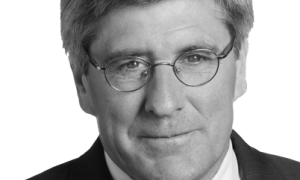“What is history but a fable agreed upon?” Napoleon said. That observation has never been more true than with the story of the Great Depression and its aftermath. With liberals today pitching more government spending “stimulus,” it’s critical we get this history right.
I’ve written before about the historical lie that President Franklin Roosevelt’s New Deal programs ended the Great Depression. After seven years of New Deal-era explosions in federal debt and spending, the U.S. economy was still flat on its back, and misery could be seen on the street corners. By 1940, unemployment still averaged 14.6 percent. That’s some recovery.
I’ve since been deluged with the same question from readers: OK, what did end the Great Depression? Again, the history books get this chapter wrong. Most history books credit the government spending to mobilize for World War II after the Japanese attacks on Pearl Harbor on Dec. 7, 1941.
It is true that, as the war started, economic output surged, and unemployment fell. But periods of all-out war are very different than peacetime. Is it any surprise that unemployment fell dramatically when nearly 12 million Americans joined the military?
My mother, a teenager at the time, told me that, during the war, when fuel was scarce and needed for the military, you wouldn’t be caught dead driving to the movie theater or a party – it was regarded as unpatriotic and selfish. People continued to produce even with high tax rates (94 percent during the war) when their tax dollars were financing the fight against the Nazis and the Japanese.
From 1942-45, America was not a free market economy; we were an all-out wartime economy – with the normal laws of economics suspended.
But a war is no way to fix an economy. Countering ISIS is not a jobs program. During World War II, when we built ships, tanks, aircraft, dropped bombs and sent our troops into harm’s way, we weren’t creating wealth.
A war is no more stimulating to an economy than a burglar stealing your money, the Japanese tsunami in 2011, Hurricane Katrina or a tornado that levels an entire town. Without such calamity, the resources spent reconstructing (or destroying, in the case of war) would be spent purchasing useful, life-enhancing products or investing in technology and capital equipment needed to boost economic output.
War in self-defense might be necessary to protect our families, but any economic growth derived from it is far less beneficial than growth derived from free people making individual decisions on what to consume and in what to invest.
In the 1940s, government spending did, indeed, surge. The federal share of GDP rose from under 12 percent in 1941 to over 40 percent in 1943-45. In other words, almost half of everything that was produced in the nation was to fight the war. Domestic spending on many FDR New Deal programs in education, training and social services dropped more than 90 percent.
The real issue is what caused the economy to surge after the war was over.
This story also is not covered in the history books. Shortly after his third reelection in 1944, and at a time when the outcome of the war was no longer in question, FDR and his domestic advisers plotted a new New Deal with such spending items as national health insurance. The Keynesians were sure that the massive postwar drop in government spending would catastrophically tank the economy.
Paul Samuelson, the dean of neo-Keynesians at that time, warned in 1943 that, unless wartime spending and controls were extended, there would be “the greatest period of unemployment and industrial dislocation which any economy has ever faced.” Business Week magazine predicted unemployment would hit 14 percent with the postwar cuts.
Here’s what happened: Government spending collapsed, from 41 percent of GDP in 1945 to 24 percent in 1946, then to under 15 percent by 1947. And there was no “new” New Deal. This was by far the biggest cut in government spending in U.S. history. Tax rates were cut, and wartime price controls were lifted. There was a very short eight-month recession, but then the private economy surged.
Personal consumption grew by 6.2 percent in 1945 and 12.4 percent in 1946, even as government spending crashed. Private investment spending grew by 28.6 percent.
The less the feds spent, the more people spent and invested. Keynesianism was turned on its head. Milton Friedman’s free-market advocacy was validated.
In 1946, the unemployment rate averaged below 4 percent and stayed that low for the better part of a decade. This all happened during the biggest reduction in government spending in U.S. history, under President Harry Truman.
In sum, it wasn’t government spending, but the shrinkage of government, that finally ended the Great Depression. That’s what should be, but isn’t, in every history book.
- Stephen Moore is chief economist at the Heritage Foundation.
Originally appeared in The Orange County Register




